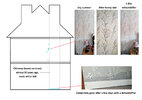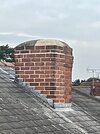- Joined
- 14 Sep 2022
- Messages
- 8
- Reaction score
- 0
- Country

Sorry to repeat this, I already posted about this a few months ago but now have a better idea of what is going on.
In a nutshell, chimney capping needed attention years ago but we have lived overseas so there has been at least 4 years of water penetration into one chimney. The chimney breast below was removed before we moved in over 25 years ago; the stack is still in the loft, but we never had damp.
Returned in July to find damp patches in the bedroom wall and above the skirting board in the dining room. Both are in line with, or near to, where the chimney breast would have been. Since had both chimneys pointed, flashing checked and capped off properly. Patches seem to improve but get darker after heavy rain. No 'roofer;' who has looked can see any issues. Some looked at the house (its a 1930's build) and just suggested we put a new roof on at around £6000, but they couldn't even promise that would fix it. Hardly any houses around here have new roofs; they are considered to be pretty good for their age.
However, just a few hours with a 20L dehumidifier on and the patches inn the bedroom disappear almost completely, same with the downstairs. Remove the dehumidifier and they start to come back within a day or so...whether it rains or not. A damp expert said that it can't be rising damp downstairs if it disappears that easily.
So, my theory is, several years of water ingress have led to a build up of damp in the walls between houses (its a semi) and even though the chimney is capped now, rainy (wet) weather still draws the damp out if there is no dehumidifier in place (possibly even salts from the old chimney). We have two Meaco Arete that are awesome, but only been running them for a few weeks so I imagine it would take months (or years) to remove the damp already in the walls. Thankfully, they are quiet and economical to run.
Does this sound a reasonable diagnosis or am I likely to need a new roof?
I attached an illustration to show what is going on
Any advice is much appreciated, even if you are not a roofing expert. Like everyone, I have better things to spend hard earnt money on than a new roof if its not needed. If it is then so be it. I would rather the house was prepared for the winter.
I should add that there is no other sign of water ingress (no water stains etc.) so it cant be water dripping into the loft or that would show on the ceiling or higher up the wall. The chimney breast remains in the front of the house (living room and bedroom) and no issues there. It was the chimney at the rear (in line with the stains) where the capping was pretty much ruined; it was clearly letting rain water go in.
Thanks in advance for any advice.
In a nutshell, chimney capping needed attention years ago but we have lived overseas so there has been at least 4 years of water penetration into one chimney. The chimney breast below was removed before we moved in over 25 years ago; the stack is still in the loft, but we never had damp.
Returned in July to find damp patches in the bedroom wall and above the skirting board in the dining room. Both are in line with, or near to, where the chimney breast would have been. Since had both chimneys pointed, flashing checked and capped off properly. Patches seem to improve but get darker after heavy rain. No 'roofer;' who has looked can see any issues. Some looked at the house (its a 1930's build) and just suggested we put a new roof on at around £6000, but they couldn't even promise that would fix it. Hardly any houses around here have new roofs; they are considered to be pretty good for their age.
However, just a few hours with a 20L dehumidifier on and the patches inn the bedroom disappear almost completely, same with the downstairs. Remove the dehumidifier and they start to come back within a day or so...whether it rains or not. A damp expert said that it can't be rising damp downstairs if it disappears that easily.
So, my theory is, several years of water ingress have led to a build up of damp in the walls between houses (its a semi) and even though the chimney is capped now, rainy (wet) weather still draws the damp out if there is no dehumidifier in place (possibly even salts from the old chimney). We have two Meaco Arete that are awesome, but only been running them for a few weeks so I imagine it would take months (or years) to remove the damp already in the walls. Thankfully, they are quiet and economical to run.
Does this sound a reasonable diagnosis or am I likely to need a new roof?
I attached an illustration to show what is going on
Any advice is much appreciated, even if you are not a roofing expert. Like everyone, I have better things to spend hard earnt money on than a new roof if its not needed. If it is then so be it. I would rather the house was prepared for the winter.
I should add that there is no other sign of water ingress (no water stains etc.) so it cant be water dripping into the loft or that would show on the ceiling or higher up the wall. The chimney breast remains in the front of the house (living room and bedroom) and no issues there. It was the chimney at the rear (in line with the stains) where the capping was pretty much ruined; it was clearly letting rain water go in.
Thanks in advance for any advice.
Attachments
Last edited:


